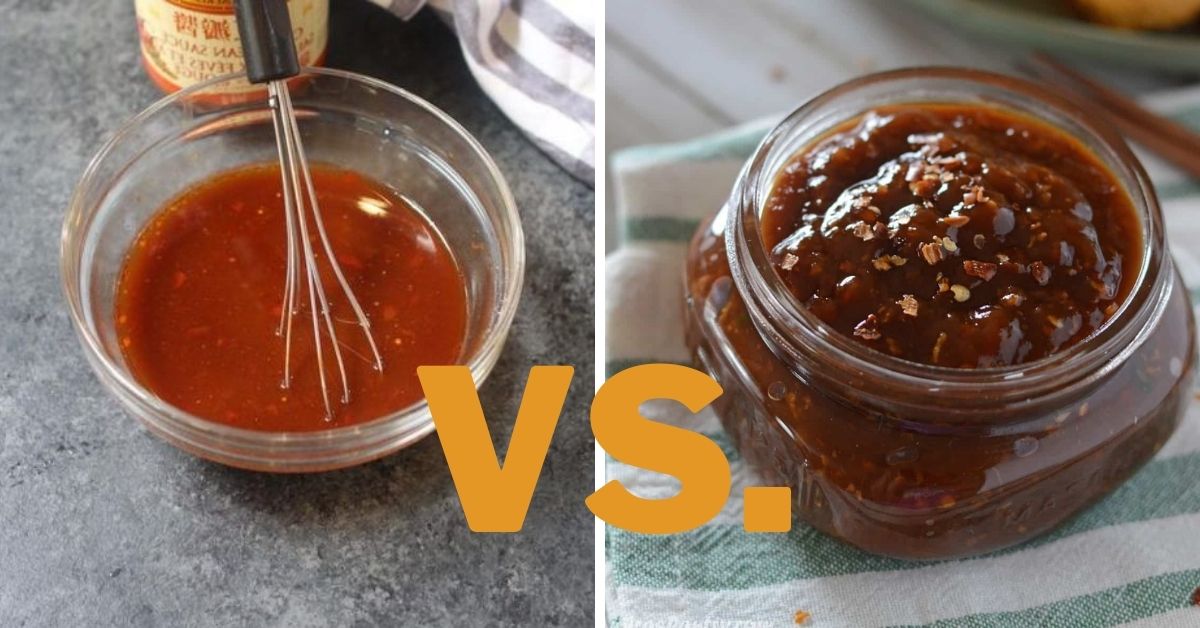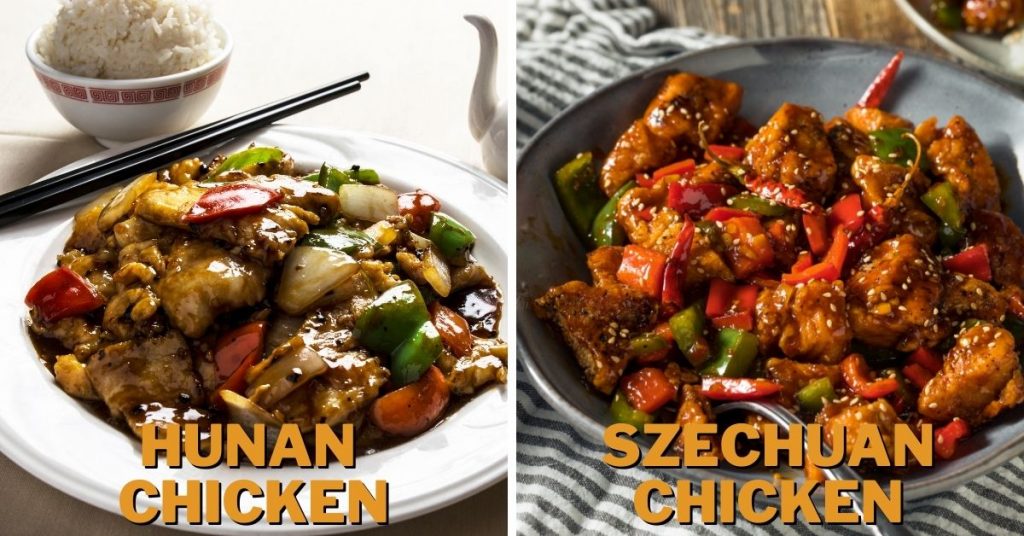Hunan vs. Szechuan: Differences & Which Is Better?

Both originating in China, Hunan and Szechuan are traditional Chinese sauces that offer many variations. They have managed to spread worldwide with time, so we have them in almost all Chinese restaurants today. Therefore, how are Hunan and Szechuan different, and which is better?
Hunan has a dry and hot flavor, while Szechuan has a mouthwatering and numbing effect. Hunan uses scallions and shallots, ginger, chili pepper, broth, cornstarch, and vinegar. Szechuan includes garlic, red bell peppers, cayenne peppers, green onions, and red chili. Both contain seasoning and soy sauce.
Both Hunan and Szechuan have an exceptional place in my kitchen and heart. They are similar, but not the same, so there are things to know about using them properly and combining them wisely. In the following paragraphs, I will share information that will be very useful to you on the differences between Hunan and Szechuan, ingredients, substitutes, and which is better.
Hunan vs. Szechuan: Differences
Although they are similar, Hunan and Szechuan aren’t the same and have substantial differences. However, which one you choose is a matter of preference, as they are both delicious and nutritious.
Ingredients
The main vegetables in Hunan are scallions and shallots, but it can also contain ginger and chili peppers. Soy sauce, chicken broth, wine vinegar, and sherry are also constituent parts of Hunan.
Still, since we are talking about food with so many variations, Hunan can also contain oyster sauce, Japanese rice wine, ketchup, and brown sugar.
Depending on your taste, you can add more or less of something, but you must keep the chili pepper as a signature ingredient, without which Hunan wouldn’t be Hunan, but gravy.
Szechuan’s ingredients are dry sherry, soy sauce, egg whites, cornstarch, Worchester sauce, chili paste, sesame oil, and brown sugar. Szechuan also includes some vegetables such as red bell peppers, green onions, cayenne pepper, red chili, carrots, and green onions. It can also contain ginger and plum.
Like Hunan, Szechuan also tolerates modifications, but chili, cornstarch, and brown sugar are the mandatory ingredients.
Taste
Both Hunan and Szechuan have an abundance of flavors. Saying that they taste salty, bitter, or sour would be a mistake, as there is an entire symphony of flavors there.
Szechuan is hot but mouthwatering, and it gives your mouth a numbing effect. It is a vibrant combination of saltiness, sourness, sweetness, bitterness, and very expressive hotness.
On the other hand, Hunan’s taste is best described as dry hot. Hunan has considerably fewer ingredients than Szechuan, so its taste isn’t as deep with as much variety.
Nevertheless, Hunan also has its magic. It tastes slightly tangy and sour, expressively salty, and, as I already mentioned, hot.
The kind and level of hotness is what defines Hunan and Szechuan and is what distinguishes them. Szechuan is very hot, but its hot flavor isn’t as expressive as in Hunan because of the sugar, cornstarch, and egg whites. Therefore, Szechuan is richly hot and numbing afterward.
On the other hand, the combination of vinegar, wine, and chili in Hunan, makes this sauce dry hot, meaning that when you taste it, the burning will be the first and last thing you feel. There will, of course, be an entire range of sourness and saltiness in between, but after each bite, your mouth will feel dry.
Appearance
Hunan is orange and light red, with deep greed shades here and there. Szechuan is primarily brown, with some orange.
Both sauces have a glazed appearance that is creamy and lumpy, which is expected as they contain chopped vegetables. They look similar, and they may even look the same to the untrained eye.
Uses
Hunan and Szechuan have similar uses, but the cooking methods are different. The dish is stewed, fried, roasted, braised, or smoked when using Hunan; when you use Szechuan, you stir-fry, steam or bras.
You can use both in protein meals containing beef or chicken, but while you fry the chicken with Hunan, you will steam it with Szechuan.
Hunan chicken or beef and Szechuan chicken or beef are the most popular dishes with these types of sauce; however, their use isn’t restricted only to these types of meat. You can top whatever you like with meat, rice, and mashed potatoes; the world is your oyster.

Nutrition
Chinese kitchen is healthy and nutritious, with small amounts of fats and significant amounts of micronutrients. The cooking methods alone contribute to this well-deserved name Chinese kitchen has made for itself.
Hunan is low in fat and calories and high in nutrients. Hunan includes protein, fiber, calcium, iron, vitamins C, B6 and K, and negligible amounts of sugar and carbs. It also contains a substantial amount of water, making it easily digestible. [1]
Hunan is great for the keto diet and other low-carb diets.
Szechuan is also very nutritious but richer in fat and calories, which is natural because it contains more ingredients. Because it contains sugar, carbs and sugars are higher in Szechuan than in Hunan, and it doesn’t contain water.
Nevertheless, Szechuan is rich in micronutrients such as calcium, sodium, iron, and vitamins A and C. However, it has a lower protein amount than Hunan, but still substantial.
Overall, both Hunan and Szechuan are healthy, nutritious, and beneficial; however, you should be careful if you have pre-existing stomach problems. Generally, hot food is considered good for the digestive tract, but it isn’t for everyone.
Although spicy food is considered good for gut health, you should be careful if you have any form of gastrointestinal inflammation or are prone to it. [2]
Origins
Hunan and Szechuan both originate in China. Hunan originated in the Hunan Region, and Szechuan originated in the Sichuan Province.
Hunan and Szechuan are essentially two types of cuisines, and the Hunan and Szechuan we are discussing here are sauces deriving from those cuisines.
In addition to Hunan and Szechuan as results from their respective cuisines, Hunan and Szechuan cuisines have their cooking methods and go far beyond Hunan and Szechuan sauces.
Popularity
Both Hunan and Szechuan are gaining popularity worldwide but still have a lot of space to grow. They are mainly popular in Chinese restaurants throughout the world, but they still haven’t expanded to households.
However, Hunan and Szechuan are becoming increasingly popular in America and Western Europe, while the south and eastern parts of Europe have yet to learn about them. In Asia, Hunan and Szechuan are popular in China and Japan, but the rest of the Asian countries are still getting to know them.
| Hunan | Szechuan | |
|---|---|---|
| Ingredients | Scallions and shallots, ginger, chili peppers, soy sauce, chicken broth, wine vinegar, and sherry. Some variations also contain oyster sauce, Japanese rice wine, ketchup, and brown sugar. | Dry sherry, soy sauce, egg whites, cornstarch, Worchester sauce, chili paste, sesame oil, brown sugar, red bell peppers, green onions, cayenne pepper, red chili, carrots, and green onions. Some variations also contain ginger and plum. |
| Taste | Discretely tangy and sour, salty, and dry hot. | Salty, sweet, bitter, sour, and expressively hot. |
| Appearance | Orange and dark red with occasional shades of deep green. | Brown and orange. |
| Uses | As meat, rice, potato, or other dish toppings. | As meat, rice, potato, or other dish toppings. |
| Nutrition | Nutritious with low amounts of fat and calories, high in protein and fiber, contains water, and has low amounts of sugar and carbs. | A little fattier than Hunan, but still low-fat ad low-calorie. Contains sugar and good amounts of micronutrients. It has a high amount of protein but lower than Hunan, and it doesn’t contain water. |
| Origins | Hunan Region- China | Sichuan Province- China |
| Popularity | Gaining popularity worldwide, but still not a part of the households’ menu. | Gaining popularity worldwide, but still not a part of the households’ menu. |
Which Is Spicier Szechuan or Hunan?
They both contain a lot of spices, but generally, Szechuan is considered spicier because it contains more ingredients than Hunan.
Still, some Hunan variations are considerably spicier than Szechuan, such as the ones that contain oyster sauce. The oyster sauce isn’t too spicy on its own, but when combined with Hunan, it brings out and amplifies its flavors.
The main feature of both is the expressive hot flavor. However, Hunan is dry hot, and Szechuan is hot but numbing.
In terms of Hunan and Szechuan cuisines, Hunan cuisine is considered spicier than Szechuan.
What Is the Hottest Chinese Dish?
Gan Guo is a dish from the Hunan cuisine, which is considered the hottest Chinese dish. However, it is among the hottest five if it isn’t the hottest.
Next in line is Hunan spicy beef, Saliva chicken- Szechuan right after, Dan Dan noodles- Szechuan, and Ma Po tofu- Szechuan.
Hunan cuisine is the spiciest in China, and its most expressed flavor is the dry hot.
What Has More Vegetables Hunan Or Szechuan?
Szechuan has more vegetables than Hunan. While Hunan contains scallions, shallots, ginger, chili peppers, Szechuan contains red bell peppers, green onions, cayenne pepper, red chili, carrots, and green onions.
What Is the Difference Between Hunan and Szechuan Style Chicken?
First of all, the Hunan chicken has a dry, hot flavor, and the Szechuan chicken has a very hot and mouth-numbing flavor.
The second difference is the cooking style. Hunan chicken uses chicken breast cooked by so-called velveting. The meat is marinated and oil-cooked before it is stir-fried with the vegetables.
Szechuan chicken uses chicken legs, which are cubed and deep-fried. After they become crispy and brown, they are mixed with the Szechuan sauce.
Hunan vs. Szechuan: Which Is Better?
Hunan is dry, hot, and less fatty than Szechuan, so it would be an excellent choice for you if you like hot and light dishes. Szechuan being richer and a bit fattier, fiery hot, and mouth-numbing, is ideal for you if you are more inclined toward a heavier and richer flavor.
It wouldn’t be fair to say that one is better, as they both have great qualities and are highly nutritious.
Can You Substitute Szechuan Sauce With Hunan?
You cannot substitute Szechuan because of the Hunan’s distinct dry, hot flavor.
Moreover, Szechuan contains more ingredients than Hunan, Worchester sauce among them, making its taste rich and specific.
Also, Szechuan is richer and fattier than Hunan, which would be very noticeable. The cooking method is another reason you cannot make this substitution.
You can, however, substitute Szechuan sauce with chili garlic sauce or tabasco.
Can You Substitute Hunan Sauce With Szechuan?
Because of their distinct flavors and the involved cooking methods, these two are not interchangeable.
You can substitute Hunan with Asian chili sauce or chili bean paste.
